Nestled on the Western slope of the Sierra Nevada mountain range live isolated patches of some of the world’s oldest and most magnificent species of tree.
The giant sequoias, the largest trees on earth, have been living in the region for thousands of years, even adapting to withstand several dozens of wildfires over their long lifetimes. But climate change, drought, heat and the increasing number of intense fires that accompany it are threatening to wipe the beloved trees off the planet.
For the second time in less than a year, an approaching wildfire inched dangerously close to an iconic plot of sequoia trees. The Washburn Fire, burning through about 3,800 acres along the southern portion of Yosemite National Park since July 7, could approach the historic Mariposa Grove, one of the most popular destinations at Yosemite and home to more than 500 mature giant sequoia trees.
Sequoia National Park, about 150 miles northwest of the Mariposa Grove, faced a similar predicament in September, when the KNP Complex Fire ravaged nearby terrain unabated.
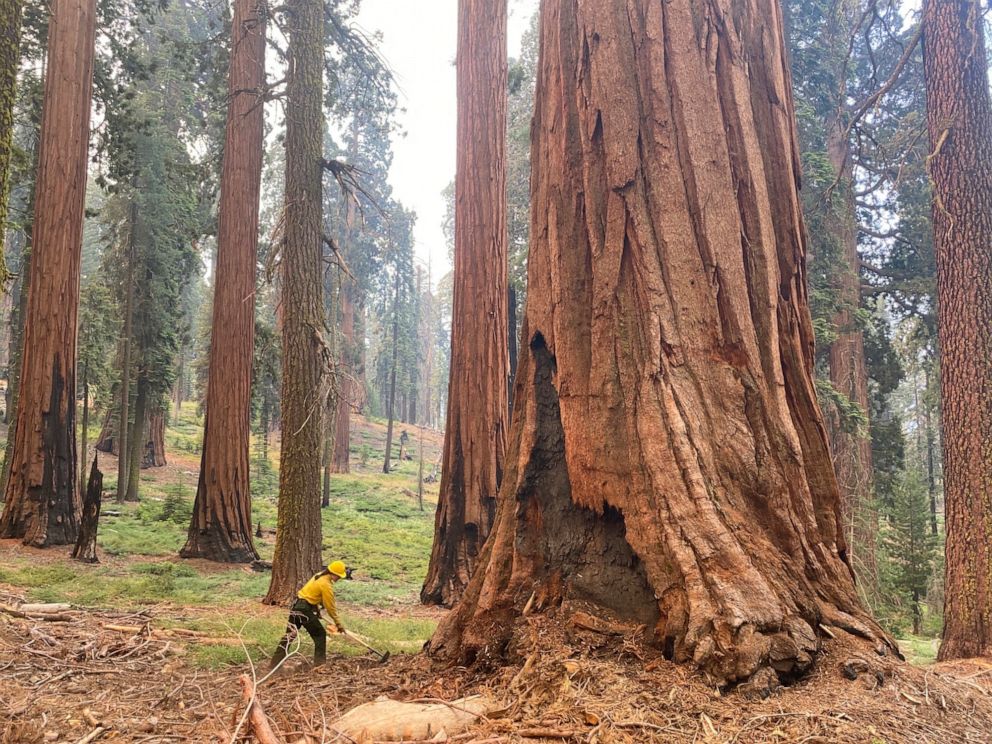 This July 2022 photo provided by the National Park Service shows a firefighter clearing loose brush from around a Sequoia tree in Mariposa Grove in Yosemite National Park, Calif.Garrett Dickman/NPS via AP
This July 2022 photo provided by the National Park Service shows a firefighter clearing loose brush from around a Sequoia tree in Mariposa Grove in Yosemite National Park, Calif.Garrett Dickman/NPS via AP
Since 2020, three fires are estimated to have killed up to 19% of the large giant sequoias in the entire Sierra Nevada population, and 85% of sequoia groves have been affected by wildfire in the past six years, according to the National Park Service.
“If we have more years like these, we’re gonna lose most of our giant sequoias, if not all of them,” Thomas Swetnam, professor Emeritus at the University of Arizona’s Laboratory of Tree-Ring Research, told ABC News.
While the sequoias are known to be fire resistant, experts say their survival is in peril as the effects of climate change gain strength.
The size of the sequoias is protection itself
Sequoias are equipped with thick, fire-resistant bark — thicker than most of the trees around them, Nate Stephenson, a scientist emeritus at the U.S. Geological Survey’s Western Ecological Research Center, told ABC News. It is “not uncommon” for sequoia trees to have bark up to 2 feet thick near ground level, serving as effective insulation at the base of the tree, Stephenson said.
In addition, the massive circumference of the base — upwards of 100 feet in many cases — allows for water transport to continue up to the crown of the tree even if a significant area on the outer tree is burned, Stephenson said.
This allows sequoias to withstand much more fire damage than other tree species around them. So much so that if an intense fire killed 95% of its leaves, it still has a “reasonable change of bouncing back from that,” Stephenson said.
“Other tree species are less likely to survive that level of scorching,” he said.
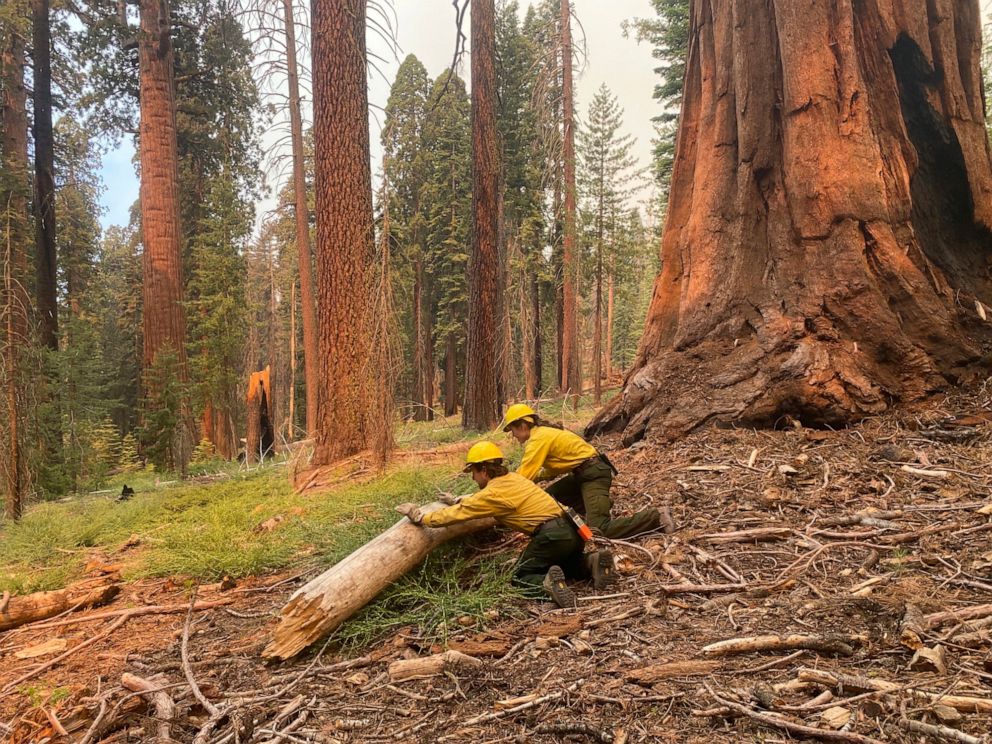 This July 2022 photo provided by the National Park Service shows firefighters clearing loose brush from around a Sequoia tree in Mariposa Grove in Yosemite National Park, Calif.Garrett Dickman/NPS via AP
This July 2022 photo provided by the National Park Service shows firefighters clearing loose brush from around a Sequoia tree in Mariposa Grove in Yosemite National Park, Calif.Garrett Dickman/NPS via AP
Sequoias are also seemingly immune to indirect effects that kill other species of trees.
When a fire weakens other forest trees, what ultimately kills them is becoming vulnerable to an insect infestation, something that rarely happens to the robust trunks on giant sequoias, Stephenson said.
Today’s fire behavior is not what sequoias are used to
Researchers who have studied sequoias note numerous burn scars on the base of sequoia trees, which prove that these trees have withstood several dozens of wildfires in their lifetimes. Ring studies for 2,000-year-old trees can show up to 80 burn scars over the tree’s lifetime, proving how fire resistant they have evolved to be, Swetnam said.
But those fires — likely flame lengths measuring at less than 3 feet, can’t compare to the infernos seen today, Adrian Das, an ecologist with the U.S. Geological Survey’s Western Ecological Research Center, told ABC News.
Natural and prescribed burns that maintained the ecosystem of the forest for thousands of years lost favor as fire officials transformed the ideology of fire management to preventing them altogether, unwittingly creating dangerous fire conditions for future generations to grapple with.
What started as fire suppression in the late 1800s later culminated into several decades of the iconic Smokey the Bear campaign warning against the sparking of forest fire, Das said. The U.S. Army, and then later the U.S. Forest Service and the National Park Service Commission, were purposely extinguishing fires, whereas ring studies show than before 1850, sequoias were living through fire events every 10 or 15 years, Swetnam said.
“Trees are always dying and falling over,” Stephenson said. “And if they just sit there on the ground without a periodic fire coming and burning them, you get more and more and more building up.”
But one of the worst droughts in recorded history in California killed tens of millions of trees between 2012 and 2016, Das said.
“The drier a fuel is, the more likely to burn the faster, hotter burning fires,” he said.
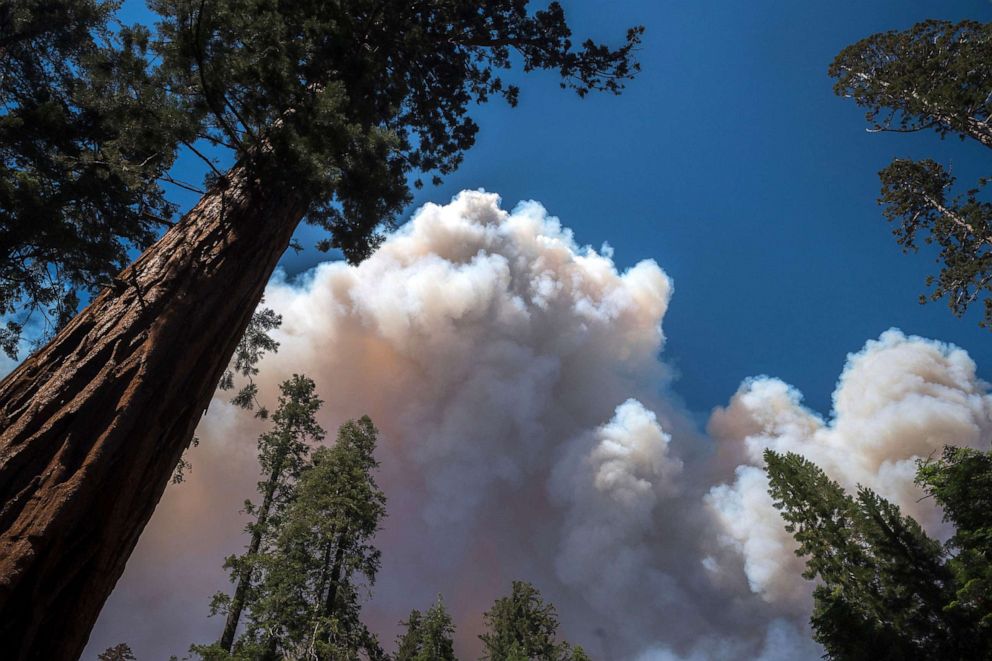 A large plume from the Washburn Fire rises over Mariposa Grove in Yosemite National Park, Calif., on July 11, 2022.Nic Coury/AFP via Getty Images
A large plume from the Washburn Fire rises over Mariposa Grove in Yosemite National Park, Calif., on July 11, 2022.Nic Coury/AFP via Getty Images
Because of the heavy fuel, fires are burning so intensely and ferociously hot that they are creating their own weather, Stephenson said. Heat emitting from the wildfires essentially create thunderstorms without rain as the pyrocumulus clouds, or fire-driven thunderstorm clouds, create pockets of heat and smoke and meet a relatively cool atmosphere.
Those high winds then feed the fire even more, Stephenson said.
Heat and drought exacerbated by climate change, combined with the plethora of accumulating fuel from millions of dead trees, are now leading to infernos with flames so high they can eventually reach the crown of sequoias, Stephenson said.
“It’s a combination of temperatures have been warming, fire has been suppressed,” he said. “If you were able to take one of those away, things wouldn’t be nearly as bad.”
What it takes to kill a sequoia
Giant sequoias can grow to more than 250 feet high, making it difficult for fire to completely overcome the massive trunk up to the crown, according to the experts.
After a century of fire suppression, plentiful fuel on the forest floor — and even “ladder fuels” consisting of dead trees that are still standing — are allowing the intense fires to reach the foliage from the crown of sequoias, Stephenson said.
Those “smaller” trees are still up to 180 feet tall, allowing the ferociously hot flames to climb farther up the sequoias than ever before, Swetnam said.
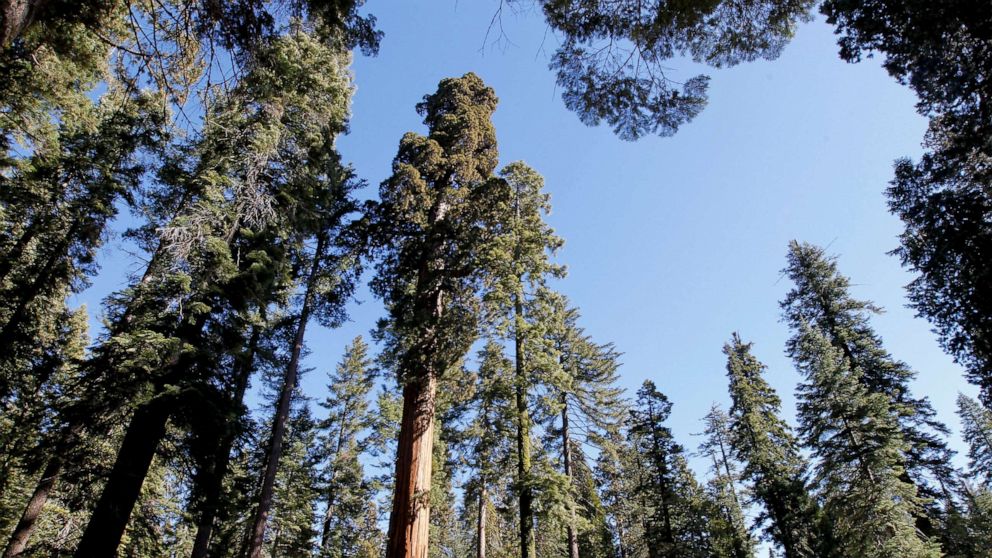 In this Feb. 26, 2013, file photo, the Mariposa Grove of Giants Sequoias is shown in Yosemite National Park in California.Michael Macor/San Francisco Chronicle via AP, FILE
In this Feb. 26, 2013, file photo, the Mariposa Grove of Giants Sequoias is shown in Yosemite National Park in California.Michael Macor/San Francisco Chronicle via AP, FILE
Once the flames reach up to 100 feet on the sequoia, they can burn for weeks or even months at a time, until the top finally falls out, Swetnam said.
“The sequoias are dying, burning out at the base and toppling over or burning out in the stem,” he said.
Swetnam described the loss of the trees as agonizing for the Park Service personnel who ensure their health.
“They’re like losing family members,” he said. “It’s heart-wrenching to see these ancient ancient trees that are so old and magnificent, beautiful.”
What can be done to protect the sequoias
As the planet warms, climate scientists warn that the things putting forests under stress — drought, heat and wildfire — are expected to occur more frequently.
In the race to protect the sequoias, National Parks rangers often head straight to the most beloved trees to protect them from an oncoming wildfire.
Over the weekend, sprinklers were set up around several trees in the Mariposa Grove, including the Grizzly Giant, the most famous giant sequoia at Yosemite that stands at 209 feet. The idea is that the steady stream of water, combined with prescribed burns, will provide enough moisture to protect the trees from becoming engulfed in flames.
Experts also hope the added humidity will decrease the likelihood that the surrounding fuel will ignite as well, Stephenson said.
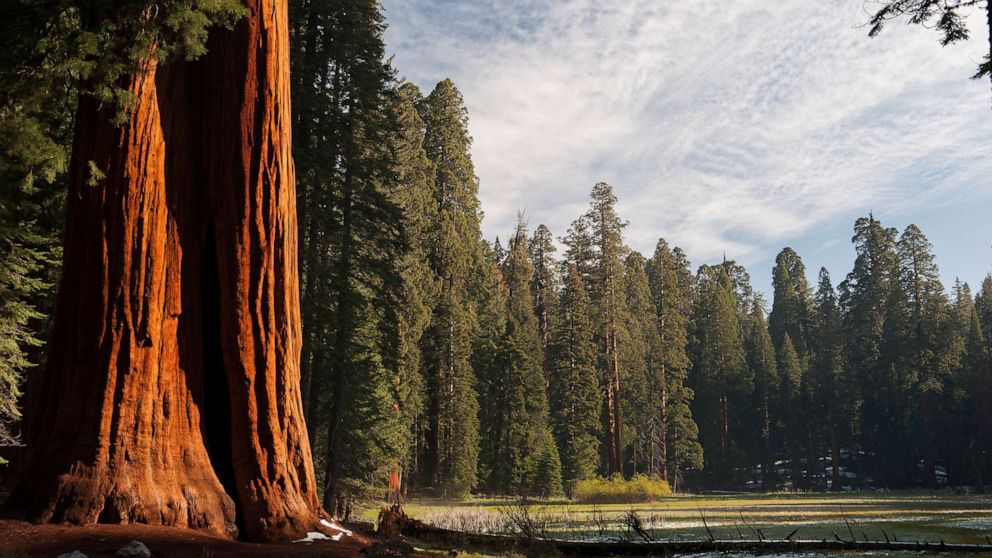 In this undated file photo, Sequoia trees are shown in Sequoia National Park in California.Getty Images
In this undated file photo, Sequoia trees are shown in Sequoia National Park in California.Getty Images
In September, the base of General Sherman, the largest tree in the world by volume at 275 feet tall and over 36 feet wide, and others at Sequoia National Park’s Giant Forest were wrapped in protective foil due to the threat of intense heat from the KNP Complex fires.
This method has its caveats, though, as the trees need to be unwrapped fairly quickly, Stephenson said. Otherwise, any embers that inevitably get underneath the foil can cook the tree from beneath the wrapping if not removed quickly enough, he added.
But the sprinklers and foil are only short-term solutions to protecting the sequoias.
In the long term, fire management consisting of removing fuel from the ground as well as cutting down the understory trees and regularly prescribed burns will also be necessary to give sequoias the best chance of survival as the consequences of climate change continue to come into fruition, Swetnam said.
“That’s the way we’re gonna get ourselves out of this problem,” he said.
Source: abcnews.go.com







